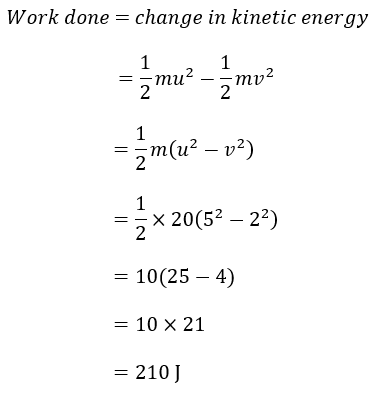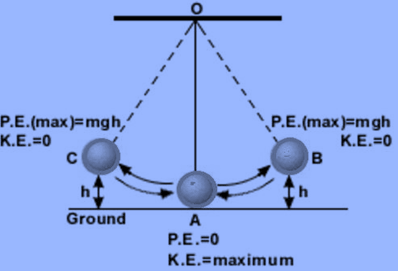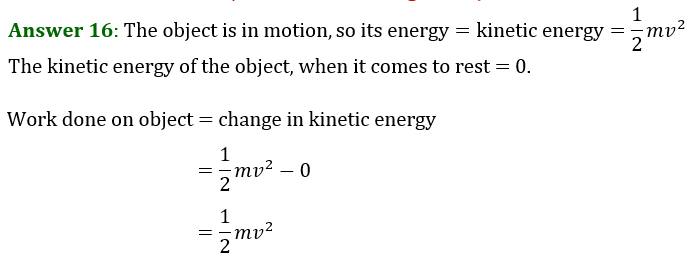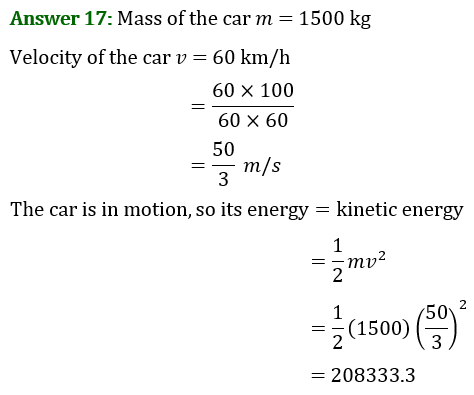NCERT Solutions for Class 9 Science Chapter 10 Work and Energy provides detailed answers for all in-text and exercise Questions. These solutions contain an in-depth explanation of each topic involved in the chapter. Students studying in class 9 can access these solutions for free in PDF format.
All these solutions are prepared by expert teachers and updated for the current academic session. NCERT Solutions for Class 9 Science Chapter 10 Work and Energy help students to understand the fundamental concepts given in class 9 Science textbook. We have prepared the answers to all the questions in an easy and well-structured manner. It helps students to grasp the chapter easily.
NCERT Class 9 Science Work and Energy Intext Questions (Solved)
PAGE NO. 115
Question 1: A force of 7 N acts on an object. The displacement is, say 8 m, in the direction of the force. Let us take it that the force acts on the object through the displacement. What is the work done in this case?

Answer: When a force F acts on an object to displace it through a distance S in its direction, then the work done W on the body by the force is given by:
Workdone = Force × Displacement
W = F × S
Where,
F = 7 N
S = 8 m
Therefore, work done,
W = 7 × 8
= 56 Nm
= 56 J
PAGE NO. 116
Question 1: When do we say that work is done?
Answer: Work is done whenever the given conditions are satisfied:
- A force acts on the body.
- There is a displacement of the body caused by the applied force along the direction of the applied force.
Question 2: Write an expression for the work done when a force is acting on an object in the direction of its displacement.
Answer: When a force F displaces a body through a distance S in the direction of the applied force, then the work done W on the body is given by the expression:
Workdone = Force × Displacement
W = F × s
Question 3: Define 1 J of work.
Answer: 1 J is the amount of work done by a force of 1 N on an object that displaces it through a distance of 1 m in the direction of the applied force. 80
Question 4: A pair of bullocks exerts a force of 140 N on a plough. The field being ploughed is 15 m long. How much work is done in ploughing the length of the field?
Answer: Work done by the bullocks is given by the expression:
Workdone = Force × Displacement
W = F × d
Where,
Applied force, F = 140 N
Displacement, d = 15 m
W = 140 × 15 = 2100 J
Hence, 2100 J of work is done in ploughing the length of the field.
PAGE NO. 119
Question 1: What is the kinetic energy of an object?
Answer: Kinetic energy is the energy possessed by a body by the virtue of its motion. Every moving object possesses kinetic energy. A body uses kinetic energy to do work. Kinetic energy of the hammer is used in driving a nail into a log of wood, kinetic energy of air is used to run windmills, etc.
Question 2: Write an expression for the kinetic energy of an object.
Answer: If a body mass m is moving with a velocity v, then its kinetic energy is given by the expression,

Its SI unit is Joule (J).
Question 3: The kinetic energy of an object of mass, m moving with a velocity of 5 m s−1 is 25 J. What will be its kinetic energy when its velocity is doubled? What will be its kinetic energy when its velocity is increased three times?

m = Mass of object
v = Velocity of the object in ms−1
Given that kinetic energy, EK = 25J
If the velocity of an object is doubled, then v = 5 × 2 = 10 ms−1.
Therefore, its kinetic energy becomes 4 times its original value, because it is proportional to the square of the velocity.
Hence, kinetic energy = 25 × 4 = 100 J.
If velocity is increased three times, then its kinetic energy becomes 9 times its original value, because it is proportional to the square of the velocity. Hence, kinetic energy = 25 × 9 = 225J.
PAGE NO.123
Question 1: What is power?
Answer: Power is the rate of doing work or the rate of transfer of energy. If W is the amount of work done in time t, then power is given by the expression,
Power = Work/Time
⇒ Power = Energy/Time
⇒ P = W/T
It is expressed in watt (W).
Question 2: Define 1 watt of power:
Answer: A body is said to have power of 1 watt if it does work at the rate of 1 joule in 1 s, i.e.,1W=1J/1s
Question 3: A lamp consumes 1000 J of electrical energy in 10 s. What is its power?
Answer: Given, Work done = Energy consumed by the lamp = 1000 J
Power is given by the expression,
Power=Work done /Time
⇒ P = 1000/10
⇒ P = 100 W
Question 4: Define average power.
Answer: A body can do different amount of work at different time intervals. Hence, it is better to find average power. Average power is obtained by dividing the total amount of work done in the total time taken to do this work.
Average Power =Total work done / Total time taken
CBSE Class 9 Science Work and Energy Exercise Questions and Answers
Question 1: Look at the activities listed below. Reason out whether or not work is done in the light of your understanding of the term ‘work’.
(a) Suma is swimming in a pond.
(b) A donkey is carrying a load on its back.
(c) A wind-mill is lifting water from a well.
(d) A green plant is carrying out photosynthesis.
(e) An engine is pulling a train.
(f) Food grains are getting dried in the sun.
(g) A sailboat is moving due to wind energy.
Answer:
(a) Suma is swimming in a pond.
Suma is doing work as she is able to move herself by applying force with the movement of her arms and legs in the water.
(b) A donkey is carrying a load on its back.
Donkey is not doing any work (in the sense of physics) as the weight he is carrying (the direction of force) and displacement are perpendicular to each other.
(c) A windmill is lifting water from a well.
Windmill is lifting water from a well and doing work against gravity.
(d) A green plant is carrying out photosynthesis.
No force and displacement are present here, so work done is zero.
(e) An engine is pulling a train.
During the pulling a train, engine does the work against the friction, present between the railway track and wheels.
(f) Food grains are getting dried in the sun.
During the drying the grains, there is no force as well as displacement is present. So, no work is done.
(g) A sailboat is moving due to wind energy.
Work is done by the wind as it moves the sailboat towards the direction of the force (force of blowing air).
Question 2: An object thrown at a certain angle to the ground moves in a curved path and falls back to the ground. The initial and the final points of the path of the object lie on the same horizontal line. What is the work done by the force of gravity on the object?
Answer: When the object moves upwards, the work done by gravity is negative (as the direction of gravitational force is towards the Earth’s centre) and when the object comes downwards, there is a positive work done. So, the total work down is zero throughout the motion.
Question 3: A battery lights a bulb. Describe the energy changes involved in the process.
Answer 3: Battery converts chemical energy into electrical energy. This electrical energy is further converted into light and heat energy.
Question 4: Certain force acting on a 20 kg mass changes its velocity from 5ms–1 to 2ms–1. Calculate the work done by the force.
Answer: Mass of the body = 20 kg
Initial velocity = 5 m/s
Final velocity = 2 m/s

Question 5: A mass of 10 kg is at a point A on a table. It is moved to a point B. If the line joining A and B is horizontal, what is the work done on the object by the gravitational force? Explain your answer.
Answer: The work down by the gravitational force acting on the body is zero because the direction of force is vertically downward and the displacement is horizontal i.e. force and displacement are perpendicular to each other.
Question 6: The potential energy of a freely falling object decreases progressively. Does this violate the law of conservation of energy? Why?
Answer: The potential energy of freely falling object decreases and its kinetic energy increases (as its velocity increases) progressively. So, in this way the total mechanical energy (Kinetic energy + potential energy) remains constant. Thus, the law of conservation of energy is not violated.
Question 7: What are the various energy transformations that occur when you are riding a bicycle?
Answer: The muscular energy of the cyclist is converted into kinetic (rotational) energy of wheels of the cycle which is further converted into kinetic energy to run the bicycle.
Question 8: Does the transfer of energy take place when you push a huge rock with all your might and fail to move it? Where is the energy you spend going?
Answer: When we push the rock and fail to move it. Some of our energy is absorbed by the rock in the form of potential energy and the rest of our energy is goes to the environment through our muscles and the surface between the rock and out hand.
Question 9: A certain household has consumed 250 units of energy during a month. How much energy is this in joules?
Answer: Energy consumed in one month = 250 unit
= 250 kWh
= 250 kW×h
= 250×1000W×3600s
= 900,000,000 J
= 9 × 108 J.
Question 10: An object of mass 40 kg is raised to a height of 5 m above the ground. What is its potential energy? If the object is allowed to fall, find its kinetic energy when it is half-way down.
Answer: We know that, potential energy = mgh
Where, m = 40 kg
g = 9.8 m/s2
h = 5 m
So, the potential energy = 40 × 9.8 × 5 J = 1960 J
According to law of conservation of energy, the total mechanical energy (Kinetic and potential energy) of an object remains constant.
Therefore, when the object is half-way down, its potential energy become half the original energy and remaining half converted into kinetic energy.
Hence, the kinetic energy = ½ (1960) J = 980 J
Question 11: What is the work done by the force of gravity on a satellite moving round the Earth? Justify your answer.
Answer: When a satellite moves around the Earth, the displacement in short interval is along the tangential direction and the force (gravitational force) is towards the centre of the Earth. Since, the force and displacement are perpendicular to each other, the work done by gravitational force is zero.
Question 12: Can there be displacement of an object in the absence of any force acting on it? Think. Discuss this question with your friends and teacher.
Answer: Yes, it is true. There may be displacement in the absence of force.
We know that, F = ma,
In the absence of force, F = 0, then ma = 0
If a = 0, the object is either at rest or in a state of uniform motion in a straight line. In case the object is moving in a straight line, there must be displacement. So, in the absence of force, there may be displacement in the object.
Question 13: A person holds a bundle of hay over his head for 30 minutes and gets tired. Has he done some work or not? Justify your answer.
Answer: The person holding a bundle of hay get tired because his muscular energy is converting into thermal energy. There is no displacement at all, so he had no work as workdone = Force × displacement.
Question 14: An electric heater is rated 1500 W. How much energy does it use in 10 hours?
Answer: We know that, Energy = Power × time
Here, Power = 1500 W
Time = 10 hours = 10 × 60 × 60 seconds = 36000 seconds
Therefore,
The energy used by heater = Power × time
= 1500 × 36000 J
= 54000000 J
= 5.4 × 107 J
Question 15: Illustrate the law of conservation of energy by discussing the energy changes which occur when we draw a pendulum bob to one side and allow it to oscillate. Why does the bob eventually come to rest? What happens to its energy eventually? Is it a violation of the law of conservation of energy?
Answer: In the given pendulum, there are three cases of points to be discussed.

At the points B and C, the pendulum bob is at its maximum height, so its potential energy is maximum and kinetic energy is zero. In this way the total mechanical energy remains constant. At the point A, the pendulum bob is at its lowest point, total potential energy is converted into kinetic energy. Now the kinetic energy is maximum and potential energy is zero. Once again the total mechanical energy remains constant
Question 16: An object of mass, is moving with a constant velocity, . How much work should be done on the object in order to bring the object to rest?

Question 17: Calculate the work required to be done to stop a car of 1500 kg moving at a velocity of 60 km/h?

The kinetic energy of the car, when it comes to rest = 0 J
Workdone on object = change in kinetic energy
= 208333.3 − 0
= 208333.3 J
Hence, the work required to stop the car is 208333.3 J.
Question 18: In each of the following a force, F is acting on an object of mass, m. The direction of displacement is from west to east shown by the longer arrow. Observe the diagrams carefully and state whether the work done by the force is negative, positive or zero.

Answer: In the first case, the force and displacement are perpendicular to each other, so work done is zero.
In the second case, the force and displacement are in the same direction, so the work done is positive.
In the third case, the force and displacement are in the opposite direction, so the work done is negative.
Question 19: Soni says that the acceleration in an object could be zero even when several forces are acting on it. Do you agree with her? Why?
Answer 19: If the resultant force acting on a body in different directions is zero, then the acceleration will be zero.
We know that,
F = ma,
In the net force is zero,
F = 0
⇒ ma = 0
⇒ a = 0 [as m ≠ 0]
Question 20: Find the energy in kW h consumed in 10 hours by four devices of power 500 W each.
Answer: The power of four devices = 4 × 500 W = 2000 W
Time = 10 hours
Therefore, the energy consumed = power × time
= 2000 × 10 Wh
= 20000 Wh
= 20 kWh
= 20 units [1 unit = 1 kWh]
Question 21: A freely falling object eventually stops on reaching the ground. What happens to its kinetic energy?
Answer: When a freely falling body eventually stops on reaching the ground, its kinetic energy gets converted into heat energy (as the body and ground become warm due to collision), sound energy and into potential energy (due to change of shape or deformation).